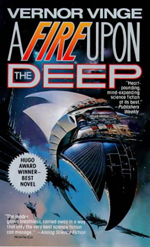 The first time I read A Fire Upon the Deep it expanded my mind: I was still a teeny-bopper and the concepts and ideas that Vinge was casually playing with were literally two or three steps beyond anything I had encountered before. For an intellectual junky like myself, the book was like a shot of adrenaline straight to the hippocampus.
The first time I read A Fire Upon the Deep it expanded my mind: I was still a teeny-bopper and the concepts and ideas that Vinge was casually playing with were literally two or three steps beyond anything I had encountered before. For an intellectual junky like myself, the book was like a shot of adrenaline straight to the hippocampus.
In the years since then I’ve read more Vinge; I’ve read Iain Banks; I’ve dabbled with Reynolds; I’ve laid in some more background with Bester’s masterpieces and Brin’s Uplift…
So this time I was able to really savor what Vinge was offering here.
First, let me say this:
A Fire Upon the Deep is cool.
I mean, there’s just no other word for it. Even after fourteen years, with hundreds of other works drawing inspiration from it, A Fire Upon the Deep remains a truly awesome work. If your sensawunda isn’t being kicked into overdrive on nearly every other page, then I name you a jaded and tragically cynical soul.
Second, let me say this:
A Fire Upon the Deep is a testament to Vinge’s growing skill as a writer.
Let me give you an example: Early in the book, Vinge dumps a character into his story as a clueless newbie to the realities of his universe. This clueless fellow allows Vinge to seamlessly integrate the basic exposition of his setting into a series of “as you NEED to know Bob” speeches. He invests these expository lumps with higher meaning because of the immediate and touching impact their revelations have on the character’s emotions and sense of self. That’s pretty good: Smooth handling of exposition in an active and character-focused manner is one of the trickier elements of the science fiction writer’s craft. But what makes Vinge incessantly clever is that he then seamlessly transforms the character’s role within the narrative into a completely different form as soon as his original purpose has been used up.
These types of subtle, sophisticated storytelling techniques can be found throughout the entire book. A Fire Upon the Deep is a mammoth novel, but there’s not a wasted character or scene. Vinge demonstrates authoritatively that he has achieved a mastery of his craft, allowing his work to reach a whole new plateau.
Finally, let me say this:
A Fire Upon the Deep is a complex work.
Its plot stretches across multiple milieus and involves several distinct casts of characters. Its thematic mesh is expressed in varied and active ways. It’s an immensely satisfying work, while still leaving the reader yearning to see deeper into its hidden depths.
Another example: One of the most prevalent themes in Vinge’s work is the way in which technology impacts the life of the individual. He carries that theme further by looking at the way in which the changing lives of individuals reshape society, and then he loops it back around on itself to show how the reshaping of society also impacts the life of the individual.
In A Fire Upon the Deep, Vinge plays with this theme on multiple levels: He shows high technology thrust haphazardly upon a primitive society. He mirrors that theme by showing a transcendant technology thrust forcefully upon a society of high technology. Simultaneously, on the individual level, he is showing a primitive shaped by technology a thousand years ahead of our own thrust into a society of even higher technology. And then he mirrors that by showing the children of high technology thrust into the extremely primitive. Around the edges he shows societies yearning for ever greater technological glories, contrasted by entities raised to the level of godhood by their technology mucking about in the playgrounds of technological children.
And in conclusion let me say this:
It is nearly impossible to satisfactorily summarize the many and varied achievements of A Fire Upon the Deep. I have not even begun to discuss, for example, Vinge’s masterful creation of a half dozen or so alien species utterly inhuman in their countenance, utterly plausible in their nature, and utterly fascinating in their execution. And even that scarcely makes a meaningful touch on the tip of the iceberg.
Vinge’s accomplishments are so varied, in fact, that the worst criticism I have ever read of A Fire Upon the Deep is this: “I liked most of it, but there was this one part/setting/character that did nothing for me.” Vinge keeps so many balls in the air that it’s almost inevitable that some people will find a ball they didn’t like. But for the lucky multitude, the balls are all beautiful creations in their own right, and the juggling act only adds to their magnificence.
There are few artistic creations which truly earn the right to be called a masterpiece. A Fire Upon the Deep is one of them.
GRADE: A+













ARCHIVED HALOSCAN COMMENTS
Justin Alexander
Well, that was quite the non sequitur. Let’s see, I discussed: Characterization. Plotting. Narrative structure. Storytelling technique. Thematic content and usage. Speculative creations. And, of course, a grade.
So, obviously, none of those constitute a review in your opinion. So what would constitute a review?
Tuesday, March 03, 2009, 3:34:37 AM
Huseyn Guliyev
YAAAAWN?
Pretending being too taken by a work to write a proper review is it?
Monday, March 02, 2009, 3:26:19 PM